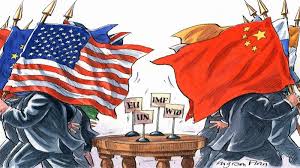U.S.-China Truce Is Just ‘Eye of the Storm’ in Trade War

The trade truce struck between the U.S. and China at the G20 summit in Osaka, Japan, this past weekend is just “the eye of the storm” in their ongoing dispute.
That’s according to economists at Bank of America Merrill Lynch, who provided a mid-year update on their economic outlook for 2019 and beyond. That outlook was altogether gloomy, featuring a downward revision to the investment bank’s global growth forecast and the sentiment that the trade dispute between the U.S. and China is “unlikely to end anytime soon,” according to Ethan Harris, BoAML’s head of global economics.
“We think [the trade war] is going to be the big story of the next year, just as it was the big story of the last year,” Harris said during a media briefing on Monday, describing the current reprieve as just “the eye of the storm.”
Aditya Bhave, a senior global economist at the bank, described the Trump-Xi truce as “a replay of the [G20] summit in Buenos Aires last December,” with the two sides agreeing to hold off on additional measures against each other while failing to resolve the existing tariffs already in place or strike a long-term resolution.
While the Osaka summit did yield some progress—most notably, looser restrictions on Chinese tech giant Huawei, which is once again allowed to do business with U.S. suppliers—the economists described a “no pain, no deal” situation in which neither country is motivated to strike a trade agreement while economic conditions remain stable.
“Both sides need to be motivated by signs of pain in the market, in the economy, and politically,” Bhave said. “With the strength of the markets and the economy, and the [Federal Reserve’s] accommodative stance, we don’t think there’s enough motivation.”
Yet economic conditions do appear to be softening globally, with BoAML cutting growth forecasts “pretty much everywhere” due to the effects of the trade war and other economic and political factors. The investment bank revised its growth outlook for the U.S. economy to 2.4% for 2019 and 1.6% for 2020, citing the fading effects of the Trump administration’s fiscal stimulus measures.
The economists also expressed worries that the ongoing trade battle would amount to “death by a thousand cuts,” given not only the implementation of broad-based import duties but also the U.S. Commerce Department’s encouragement of “any company that thinks it’s being treated unfairly to make a [trade] complaint,” Harris said.
May saw a surge in such complaints, with 11 different cases targeting $ 4 billion in imports from China, Germany, Mexico, India, Turkey, and France, among other nations. Harris noted “huge” proposed countervailing duties on those imports, often amounting to “hundreds of percent.”
The Fed’s more dovish stance on interest rates, meanwhile, will likely only drag the trade dispute out further—removing the Trump administration’s incentive to strike a deal in the interest of alleviating concerns about the economy.
“They’re helping growth, but also taking the pressure off the Trump administration,” Harris said of the Fed’s stance. “It means the trade war continues to escalate, because there’s no market or economic pain from the trade war.”
